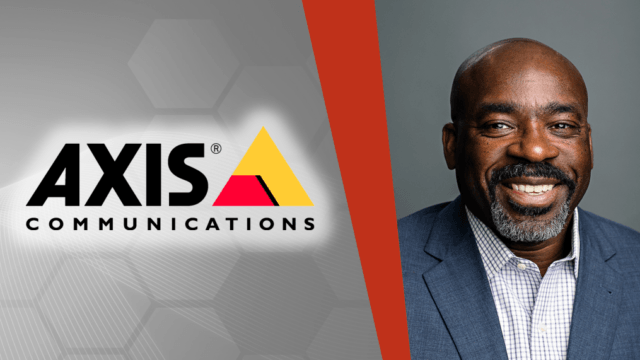Financial institutions rely on Convergint Technologies to proactively and cost-effectively manage physical security strategies that protect their critical infrastructure. Convergint integrates existing IT systems with disparate building systems to increase situational awareness, mitigate risk, and maintain compliance.
One of Convergint’s premium financial partners is Axis Communications, a leader in providing network cameras and other security solutions. Subject matter expert Stephen Joseph, Business Development Manager at Axis Communications, discusses security solutions and trends within the financial industry.
Tell us about your professional background.
I currently serve as the business development manager for the banking and finance segment at Axis Communications, Inc. In this role, I leverage more than 35 years of industry experience to drive Axis’ educational efforts with banking and finance integrator partners and end-customers, in order to impart the benefits of migrating from analog CCTV to IP video.
Prior to joining Axis in 2013, I worked closely with banking and finance customers while at Tyco Integrated Security. I began my career as a field service technician and was promoted through the ranks to numerous customer-facing positions, including national account manager and, most recently, regional relationship manager.
I earned the ASIS International Physical Security Professional (PSP) credential in 2013 and am a member of the Vendor Advisory Committee for the National ATM Council (NAC) and the Security Forum Committee for the ATM Industry Association (ATMIA).
What do you think are some of the biggest challenges faced by the financial vertical as it relates to security?
Despite what most people may think, financial institutions tend to tread very cautiously when it comes to adopting new physical security technology. Operational budgets are small and maximizing spend dollars and leveraging existing technology seems to be the norm. In other words, if it’s not broken, don’t fix it. Years of investing in proprietary technology has taken its toll, making it very costly to upgrade older security systems.
Even some of the largest financial institutions don’t have a consistent strategy for keeping up with advancing or emerging technology and have allowed the price to be the determining factor in their overall strategy. Most take a very reactive approach to their overall security strategy. With shrinking staff having to do more with less, a corporate security manager has very little time to stay on top of the latest and greatest physical security technology.
What do you think are some of the biggest mistakes made by the financial industry?
Most corporate security teams have been traditionally staffed by retired law enforcement to gain specific relationship benefits with local law enforcement. At the same time, corporate security has traditionally been very siloed from chief technology counterparts. This siloed approach hasn’t allowed for collaboration with IT, and many physical security systems were purposely kept off corporate networks to maintain control.
This has not allowed for institutions to be well prepared for the future of physical security technology, and with bandwidth at a premium, allocations were kept for operational purposes. The bottom line is that many institutions are playing catch up regarding sharing control with IT counterparts and fully understanding network standards, policies, and procedures.
Do Axis Communications’ solutions apply to large or small financial institutions?
Axis Communications provides a quality product that is also highly scalable when combined with other technologies in the marketplace. Size really doesn’t factor in and is a non-issue because we have products and solutions that can meet the demands of small, medium, and enterprise-class end users. The additional options we make available provide the possibility of financial institutions to develop a manageable migration strategy. These options allow financial institutions to only take on what they can handle while budgeting for taking these incremental steps and leveraging their existing infrastructure investment.
How do regulations impact security in the financial industry?
Regulations are very consistent across the board within the U.S.; however, some states have localized regulations specifically around ATM’s. Global institutions are faced with the regulations of each specific country – mostly around privacy laws. There aren’t written standards for the industry as a whole, but most follow shared standards for areas like video storage, which has been 90 days on average. Ultimately, every institution makes their own decision on what they feel works best for them unless there are specific government regulations that are mandated.
How can these solutions positively impact a financial institution’s way of doing business?
The new technology solutions that are available today are open-sourced and allow for greater flexibility and scalability. There’s no longer a need to get boxed in with a proprietary solution which can make it very hard to be nimble and change as your needs change. It also makes it very easy to integrate with other products and solutions in order to take full advantage of new and emerging technologies. Some of the new analytic solutions are allowing for operational benefits which can help with operational efficiencies. With spend dollars being limited, this provides for the ability to maximize spend and then build on the investments being made for the long term. When you consider the overall ROI, you’ll get more ‘bang for your buck.’
What benefits do you think a financial institution receives when partnering with Axis Communications and Convergint?
There’s a saying that you get what you pay for. Many financial institutions are now reaping what they sowed concerning investing in proprietary technologies. With Axis and Convergint, they’ll get trusted partners that offer quality products and solutions. They’ll also be able to take advantage of our vast product portfolio and partner network that can provide solutions to meet their current and future needs. Together we can equip a financial institution to meet the demands and needs of a segment that’s looking for future solutions and guide them on that path.
How important is cybersecurity in the financial vertical?
Cybersecurity has been a buzzword for quite awhile, but many financial institutions are starting to take very serious steps regarding developing an official cybersecurity strategy for vetting physical security technology. Many have gone as far as bringing on cybersecurity leads that specifically support physical security. Corporate security managers have started coming out of their silos and have started working much closer with their IT counterparts so they can be better prepared to leverage current and emerging products and solutions that require network connectivity.

